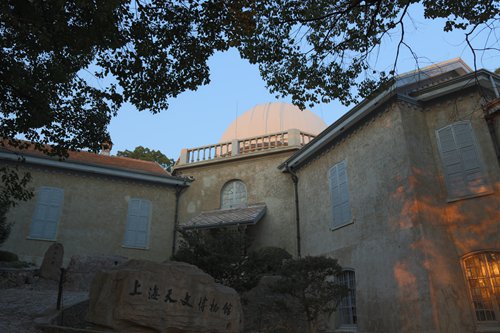
Entrance of the Shanghai Astronomical Museum (Photo/GT)
The planetarium of the Shanghai Astronomical Museum has reopened to the public after receiving extensive upgrades in its facilities.
The museum, located at the very top of West Sheshan Hill in Songjiang district, was transformed by Shanghai Astronomical Observatory (SHAO) of Chinese Academy of Sciences in 2004 out of an older observatory established by a French Catholic missionary in 1900.
Equipped with a large-scale astronomical telescope and a dome, the observatory was China's first modern observatory and one of the most important birthplaces of China's modern astronomy.
In 2004, the museum constructed China's first interactive digital planetarium. After several years in operation, the facilities gradually became outdated. Moreover, the presentation effects were poor due to technical limitations.
To better serve the public, the museum began upgrading the planetarium in 2017. Tang Haiming, senior supervisor from the scientific communication office of SHAO, told the Global Times that the museum has integrated a professional projection system into its dome screen and updated the control system, which has brought significant improvements to the presentation.
Sharing with the world
The planetarium is now fully compatible with World Wide Telescope (WWT), a virtual observatory developed by Microsoft Research consisting of extensive observational data from professional observatories and institutions such as NASA, Hubble Space Telescope, Sloan Digital Sky Survey, Chandra X-ray Observatory and China's LAMOST (Large Sky Area Multi-Object Fiber Spectroscopic Telescope).
Considering that the general public has a limited understanding of astronomy, the museum has found a new and easy way to better educate audiences on astronomy by creating dome-screen movies incorporating the most updated data.
"In the past, we entrusted a third-party company to do this, which required a large investment," Tang said. "It is much easier now, as we can make it ourselves with the new system."
This system also allows users to develop and play their own universe-roaming videos, which will enhance the educational function of the museum. According to Tang, the museum will take on more educational responsibilities such as organizing activities about popular scientific subjects.
"It was challenging to hold an education activity before, because we needed to prepare all the materials prior to the class. But now, the new system allows real-time network connection, so we can obtain the most updated teaching materials," said Tang.
Tang told the Global Times that anyone can gain access to WWT. "The virtual observatory is an open platform covering many astronomical equipment which share their data with the public," he said.
He said that many Chinese institutes and research groups are also opening and sharing their data to the public now. In the meantime, China is building its own virtual observatory, which has drawn interest from domestic and overseas scientists.
"We have plenty of large-scale equipment in China now that can produce volumes of valuable data. It would be a pity to let this data just sleep in a database," he said.


















































